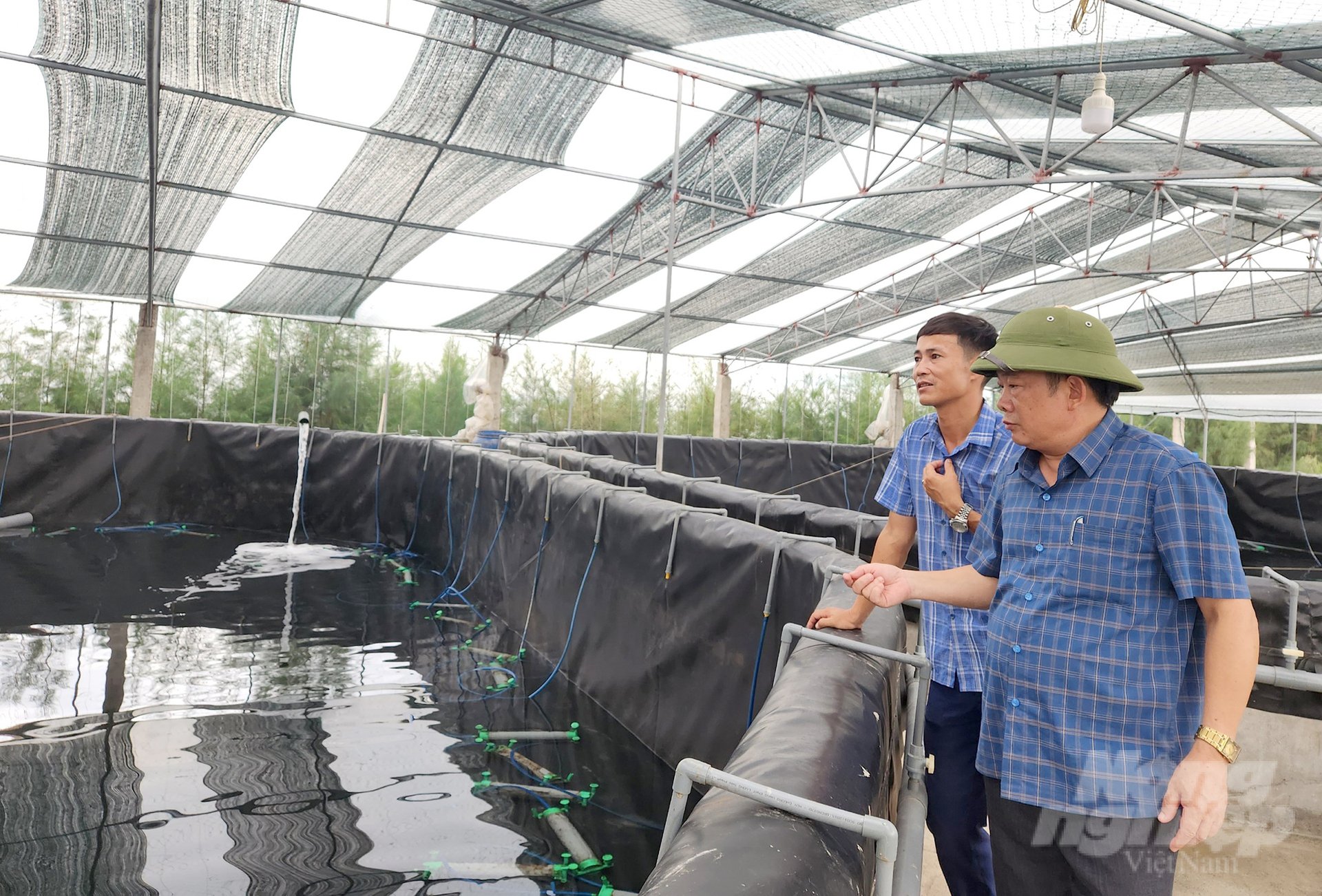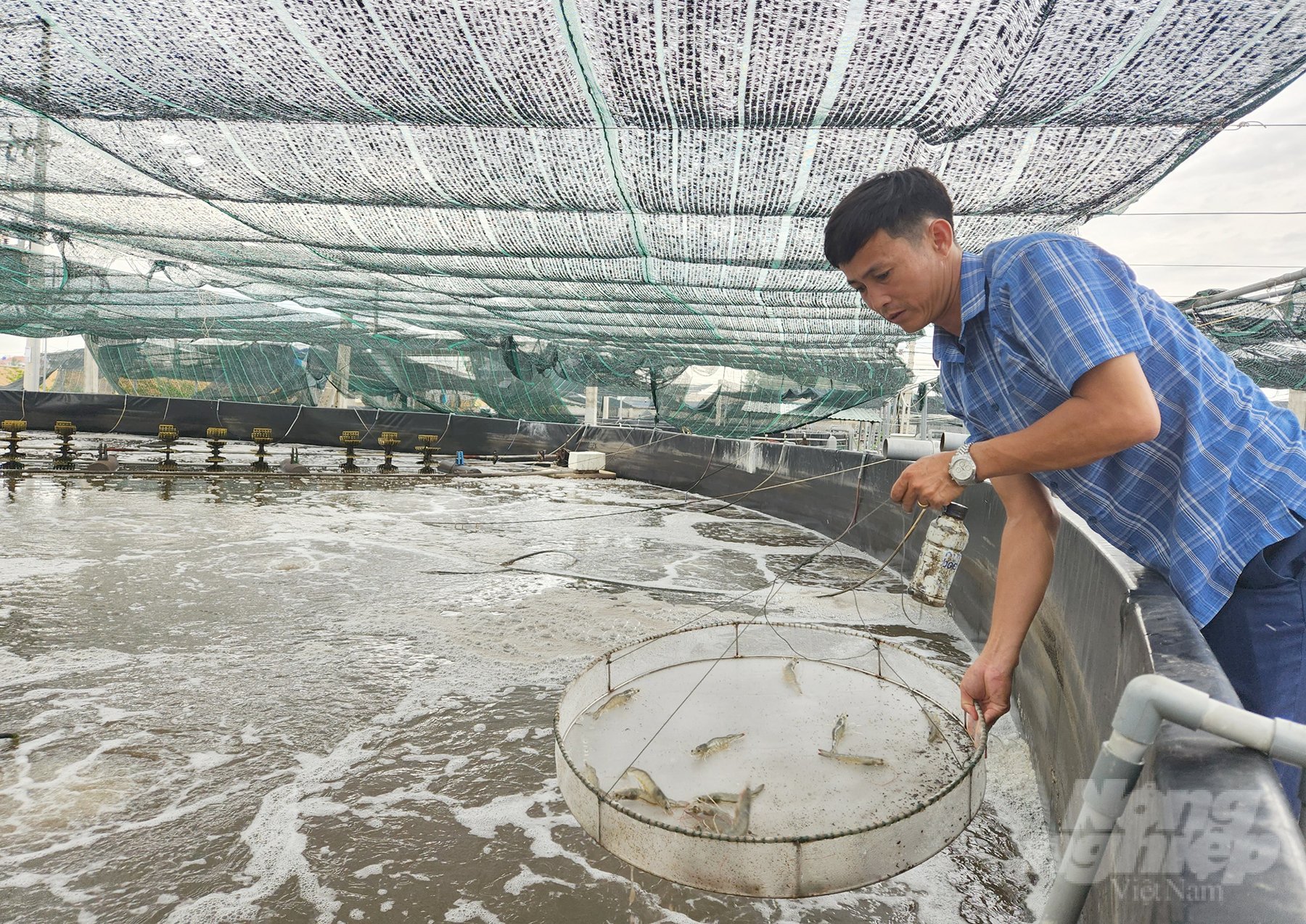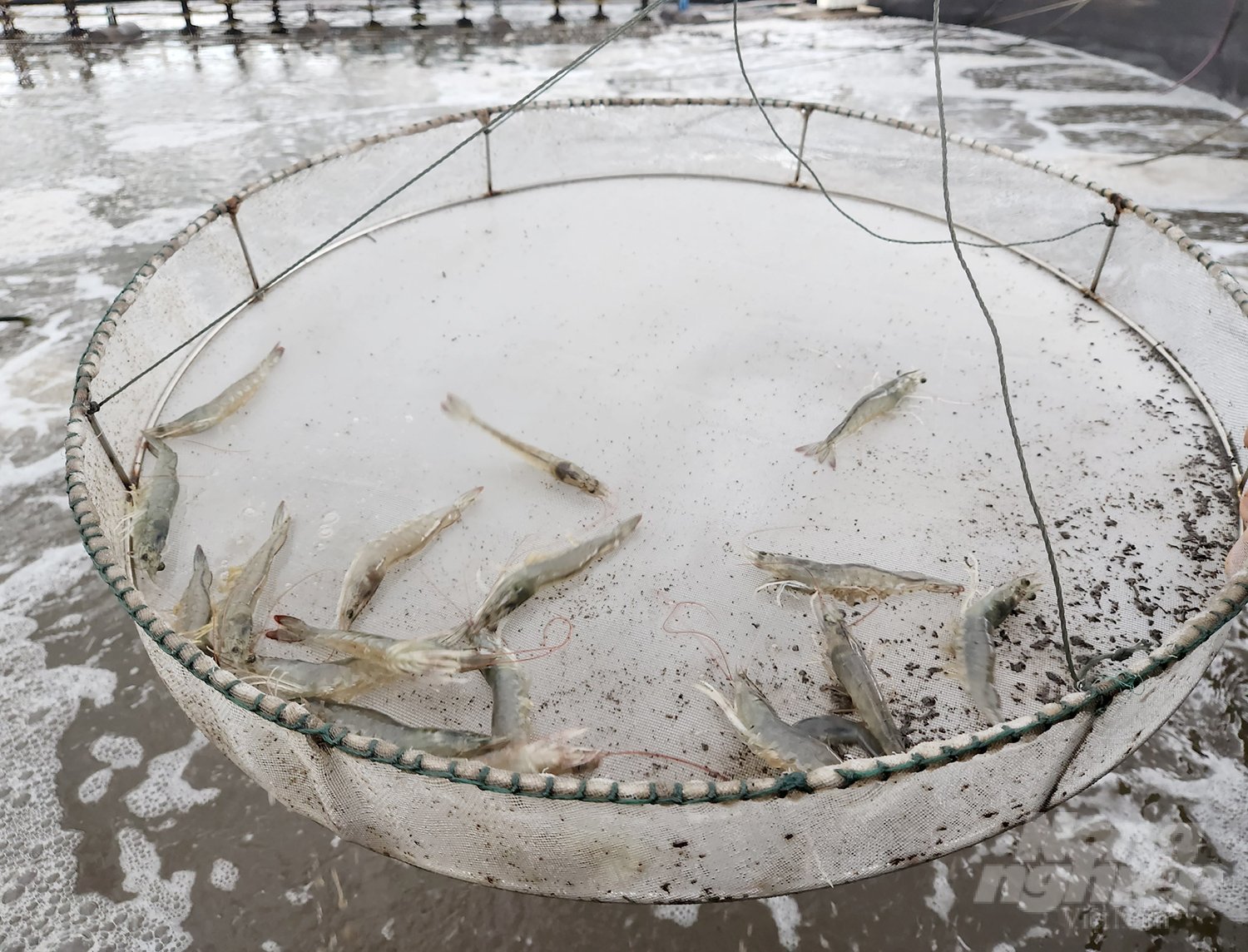May 30, 2025 | 10:47 GMT +7
May 30, 2025 | 10:47 GMT +7
Hotline: 0913.378.918
May 30, 2025 | 10:47 GMT +7
Hotline: 0913.378.918

Mr. Ngo Dinh Tuu, Chairman of Dien Chau District Farmers' Association (outermost) inspects a high-tech shrimp farming model on sand. Photo: Viet Khanh.
“The whole Dien Chau district has dozens of kilometres bordering the sea, this is the potential and advantage given to the locality to develop the aquaculture industry. In the context of increasingly unpredictable climate change, and epidemics spreading due to heavily polluted environments, people have focused on applying science and technology, boldly applying advanced technology into farming to limit risks and improve economic value.
On the previously empty salty sand spaces, more than 100 households have spared no expense and effort to build high-tech shrimp farming models. In the coming time, we will expand beyond these 200 ha", Mr Ngo Dinh Tuu, Chairman of the Dien Chau District Farmers' Association shared.
Among the above-mentioned households, not everyone enjoys the pleasure, even many people suffer heavy losses. Particularly, Mr. Nguyen Van Hoa, born in 1983, and residing in Dien Kim commune, has had great success, at least up to this point. It should be known that the man in his forties belongs to the forefront generation, boldly reaching out from the traditional mould to adopt whiteleg shrimp 3-stage high-tech farming in this sunny and windy flat land.
People in the profession insist that shrimp farming "consumes" huge investment costs, so if the business sails with the wind, then it will be a step forward, otherwise, the investors will always face the chance of being empty-handed. Traditional farming is already expensive, raising shrimp in 3 stages is even more difficult, and the pressure is doubled. Mr Nguyen Van Hoa himself, whenever he thinks back on the past journey, also startled at times. It is true that investing in shrimp helps him to be able to make a living, but in return, it comes with long nights of staying awake, tossing and turning, with thoughts that are always fighting and struggling.

Mr. Nguyen Van Hoa is one of the pioneers in the application of high-tech shrimp farming in 3 stages. Photo: Viet Khanh.
After consulting with friends and relatives, they too advise him not to gamble with too much risk. But he thought that if he accepted his fate, he would never be able to make a living, soaring determination gradually moulded into an iron will, and by 2019 he officially fell in passion with shrimp farming. Being a newcomer in this profession, he only dared to invest in 3 ponds to have the best overview. After a year of careful monitoring, realizing that the situation was progressing smoothly, Mr Hoa decided to gamble with all his hands, mobilize more VND billions, and replicated it to 16 ponds, including 13 shrimp ponds, the rest were sedimentation ponds or filter.
Three-stage hi-tech shrimp farming has many outstanding advantages, especially in reducing the risk of environmental pollution and water sources, especially when the rainy season hits. The difference comes from the air duct system with 2 separate sources. The first is the source of the air compressor, the air outside the environment passes through the plastic pipe system, flowing through the nanowire (very small gas units). After being screened, it will approach and increase the ability to diffuse oxygen into the water. The second is to use a water fan to increase the solubility of oxygen, and at the same time to collect garbage and waste deposited in the water and take it out.
“The 3-stage hi-tech process helps farmed shrimp achieve high survival rates, and maintain rapid growth and development. In the main crop, the total yield usually ranges from 20-25 tons, with the selling price of about VND 140,000 VND/As of now, the total revenue can reach the threshold of VND 3 billion or more, minus the interest expense of about 1/3. If favorable, each year growers can raise 2-3 generations.
Since entering the profession until now, the biggest hit is the winter crop in 2022. With 13 ponds with a total output of 25 tons, closer to Tet, the demand for purchasing is bigger, and the price doubles on normal days, helping the family make a net profit of nearly VND 3 billion. The output of whiteleg shrimp is quite stable. I deploy it in the direction of high technology, which is more convenient in exporting, usually, traders come to the farm to collect shrimp, sometimes I don't even have shrimps to sell", farmer Nguyen Van Hoa shared.
For each crop, Mr. Hoa's family releases from 1-1.2 million seeds, the total cost is about VND 2 billion. Shrimp reaching an average weight of 50-60 heads/kg is to start selling, rarely to the size of 30-40 shrimps/kg because it is difficult to raise and has high cost and risks.

Shrimp farming in 3 stages minimizes disease and improves product quality. Photo: Quoc Toan.
The 3-stage shrimp farming model not only helps owners to make a profit, but its beauty is creating a very positive spillover effect. "The good news spread far away, many people did not mind the long distance, and took the effort to find "the teacher and study the way". Not to mention the model also directly solves the problem of jobs for 5 main workers with a salary of VND 7-10 million, not to mention 10-15 other seasonal workers.
Although the situation is going smoothly, with his rich experience, Mr Hoa understands that everything is not quite rosy: “The shrimp farming industry faces many difficulties, from controlling the quality of inputs to throughout the farming process, the shrimp still in the lake are risky. The winter season is extremely scarce because of too many risks, suppliers only produce in moderation. In the summer, I worried that prolonged hot sun creates favourable conditions for EHP (microsporidian disease) to spread on a large scale. There was a new period of stocking for about a week when the disease appeared rampant, the family worried sick.
The difficulty at this time is that the price of shrimp is on the decline while accompanying services such as food, medicine, and transportation have skyrocketed. This causes farmers to go through many hardships. Winning and losing is a normal thing in business, but knowing that, it's better to be careful", said Mr. Hoa with a laugh.
Translated by Hoang Duy
/2025/05/25/4127-3-073637_820.jpg)
(VAN) Thanks to the promotion from an FAO-implemented project, vegetable production in greenhouses in Moc Chau has seen strong development, from 1.5 hectares in 2021 to nearly 50 hectares in 2024.

(VAN) FAO has recently supported USD 140,000 to implement the project 'Risk mitigation human-animal interface risks through disease control initiatives in pig farming.'

(VAN) The People's Committee of Tra Vinh province has approved an adjustment to the investment policy for the Green Hydrogen Plant project, increasing its area to approximately 52.76 hectares.
![Reducing emissions from rice fields: [2] Farmers’ commitment to the soil](https://t.ex-cdn.com/nongnghiepmoitruong.vn/608w/files/news/2025/05/05/dsc08881jpg-nongnghiep-140632.jpg)
(VAN) Clean rice cultivation model in Thuong Tan commune, Bac Tan Uyen district, is assisting local residents in achieving sustainable agriculture by substantially reducing costs, increasing productivity, and protecting the environment.

(VAN) At the conference to disseminate Resolution No. 68, AgriS introduced its digital agricultural ecosystem and reaffirmed its commitment to accompanying the Government in promoting private sector development and sustainable agriculture.

(VAN) 'Blue Ocean - Blue Foods' initiative is designed to restore marine ecosystems and establish sustainable livelihoods for local communities by cultivating a minimum of 1,000 hectares of cottonii seaweed in the first three years.
/2025/05/21/4642-3-112707_603.jpg)
(VAN) The V-SCOPE project has made direct contributions to three out of six pillars of the Comprehensive Strategic Partnership between Vietnam and Australia.